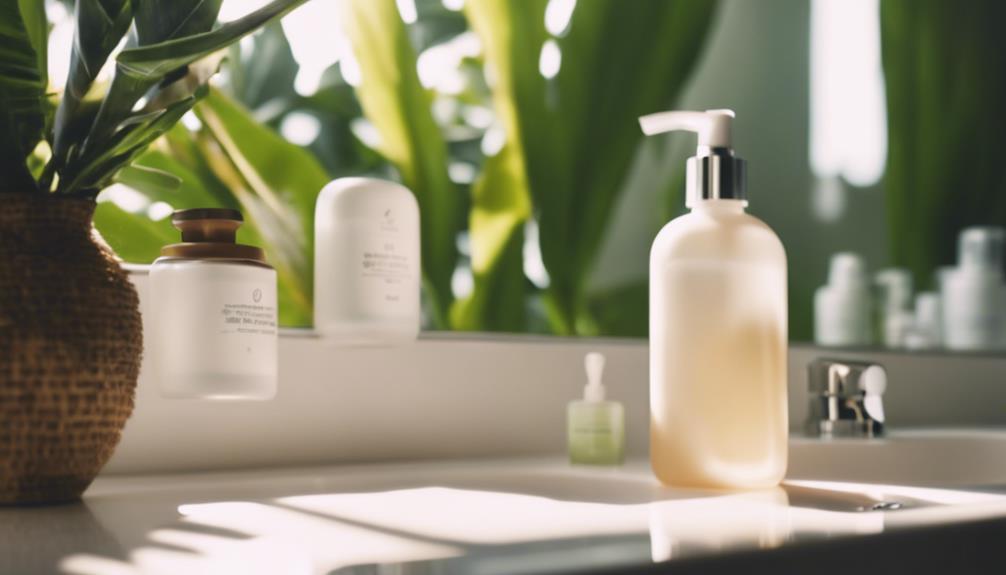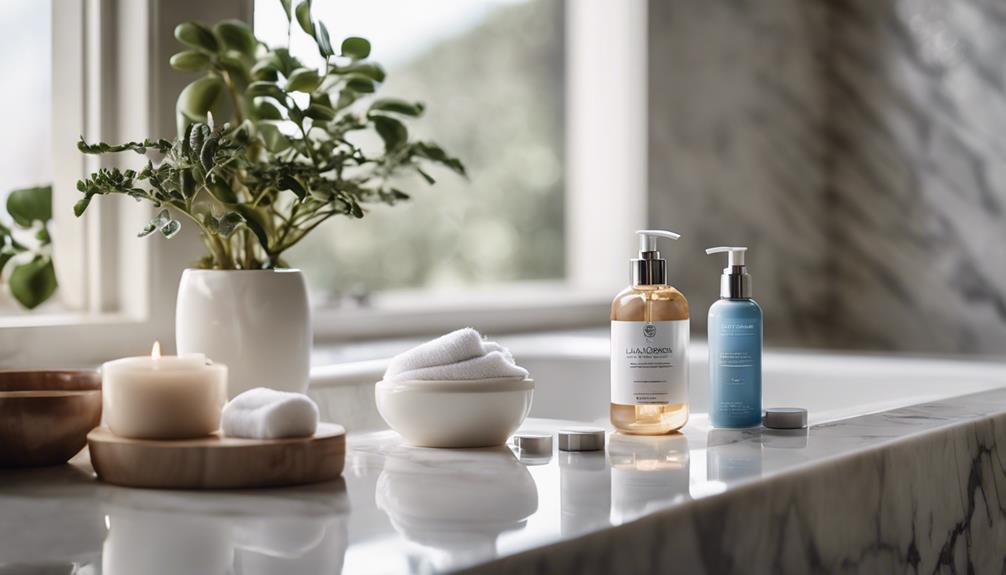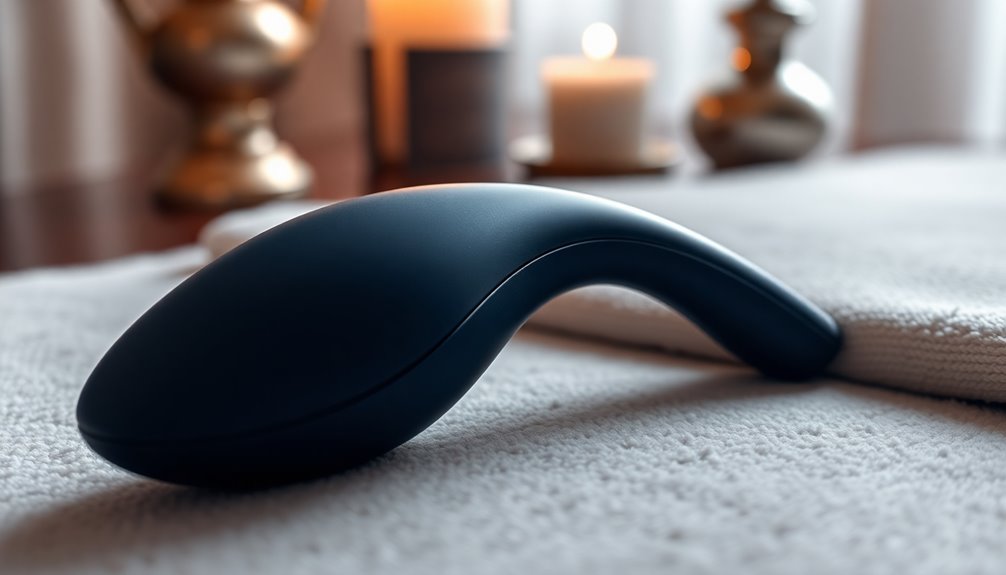You must put on sunscreen as the final step of your morning skincare routine, ideally 15-30 minutes before sun exposure for optimal effectiveness. Choose a broad-spectrum sunscreen with a minimum SPF of 30 to protect your skin from harmful UV rays. Remember to cover often forgotten areas such as your ears and neck, applying approximately one ounce for complete coverage. If you are using a chemical sunscreen, apply it before moisturizer; for a physical sunscreen, apply it after. Don’t forget to reapply every two hours, especially if you are swimming or sweating. There is a lot more to learn about sunscreen usage and its benefits in the future.
Key Takeaways
- Apply sunscreen as the final step in your morning skincare routine, before any makeup.
- Use broad-spectrum sunscreen with at least SPF 30 for adequate protection against UV rays.
- Apply sunscreen 15-30 minutes before sun exposure for maximum effectiveness.
- Reapply sunscreen every two hours, especially after swimming or sweating.
Importance of Sunscreen
Using sunscreen daily is essential because it protects your skin from harmful UV rays, greatly reducing your risk of skin cancer and other long-term issues.
Incorporating a broad-spectrum sunscreen with at least SPF 30 into your skin care routine is a must for maintaining skin health. This level of protection safeguards against both UVA and UVB rays, which can lead to premature aging and discoloration over time.
To maximize the benefits, you need to reapply sunscreen every two hours, especially if you're spending time outdoors or sweating.
Consistency is key; just like other skin care practices, sunscreen application should be a daily habit.
The active ingredients, such as titanium dioxide and zinc oxide, provide a physical barrier against UV exposure, enhancing your skin's protection.
Types of Sunscreen
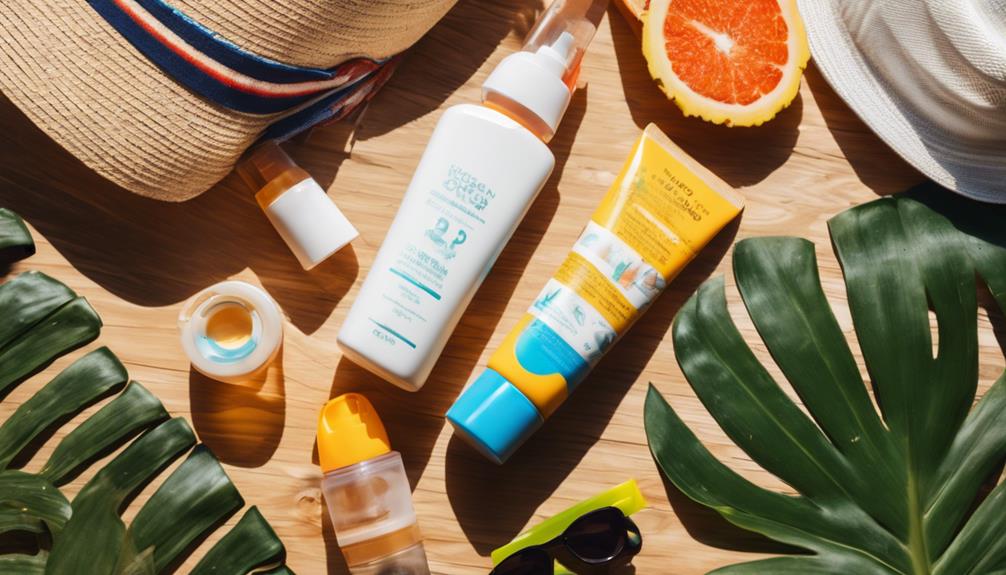
When choosing sunscreen, you'll encounter two main types: chemical and physical. Each has its own way of protecting your skin from harmful UV rays, so it's crucial to understand their differences.
Plus, selecting a broad-spectrum option guarantees you're covered against both UVA and UVB radiation.
Chemical Vs. Physical Sunscreens
Choosing between chemical and physical sunscreens can make a significant difference in how well your skin is protected from harmful UV rays.
Chemical sunscreens contain active ingredients that absorb UV radiation and convert it into heat, while physical (mineral) sunscreens contain zinc oxide or titanium dioxide that reflect UV rays away from your skin.
When selecting the right sunscreen, consider your skin type and individual sunscreen needs. If you have sensitive skin, you might find that physical sunscreens are more suitable, as they provide immediate protection and are less likely to cause irritation.
On the other hand, broad-spectrum chemical sunscreens can effectively protect against both UVA and UVB rays, but should be applied before your moisturizer for proper absorption.
Mineral sunscreens, a type of physical sunscreen, are often preferred for their gentle formulation and environmental safety, particularly regarding coral reefs.
Ultimately, both chemical and physical sunscreens can offer effective UV protection, so finding the one that best fits your lifestyle and skin type is essential for maintaining healthy skin.
Broad-Spectrum Protection Importance
Broad-spectrum protection is vital for safeguarding your skin against the harmful effects of both UVA and UVB rays, making it a key factor in your sunscreen choice. These UV rays can lead to skin cancer and accelerate aging, so you need a sunscreen that shields your skin effectively. Look for a product with a minimum SPF of 30 to guarantee adequate defense.
There are two main types of sunscreen: chemical and physical. Chemical sunscreens absorb UV radiation, while physical sunscreens, containing active ingredients like zinc oxide or titanium dioxide, reflect UV rays. Both types can provide broad-spectrum protection, but you should choose what works best for your skin type and lifestyle.
To maintain your skin health, apply sunscreen every two hours, especially if you're sweating or swimming. A water-resistant formulation can act as a protective barrier during outdoor activities.
Application Timing
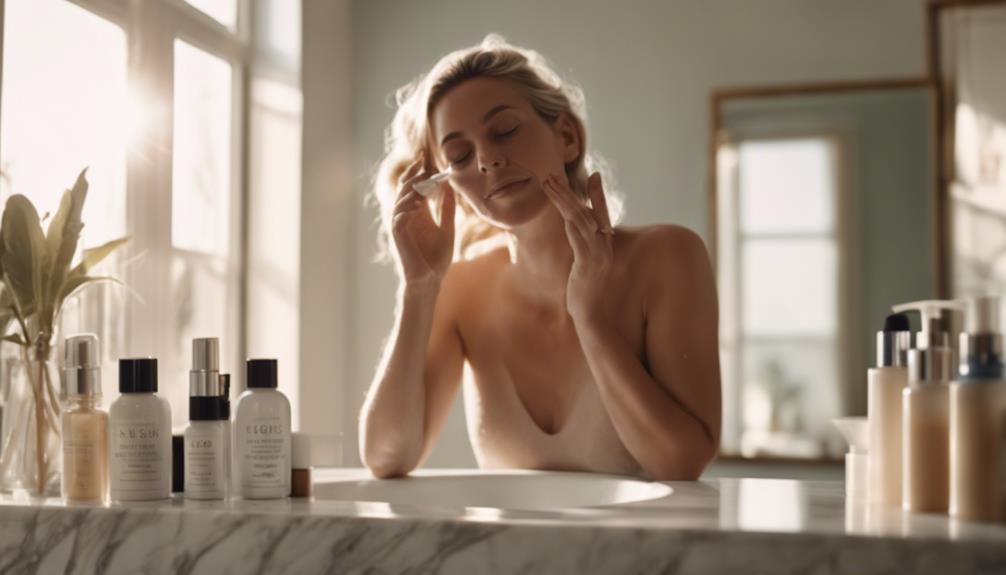
Apply sunscreen 15-30 minutes before sun exposure to guarantee it absorbs properly and provides maximum protection. This timing is essential for achieving ideal absorption, ensuring the sunscreen effectively shields your skin from harmful UV rays.
Incorporate sunscreen as the final step in your skincare routine, right after cleansing, toning, and applying any treatments or moisturizers. This order allows the sunscreen to form a protective barrier without being diluted by other products.
For those using makeup, remember to apply sunscreen first, followed by your moisturizer and makeup. This order preserves the sunscreen's effectiveness, allowing it to deliver day protection throughout your activities.
If you're headed outdoors, make it a habit to include sunscreen in your morning routine.
Proper Application Techniques
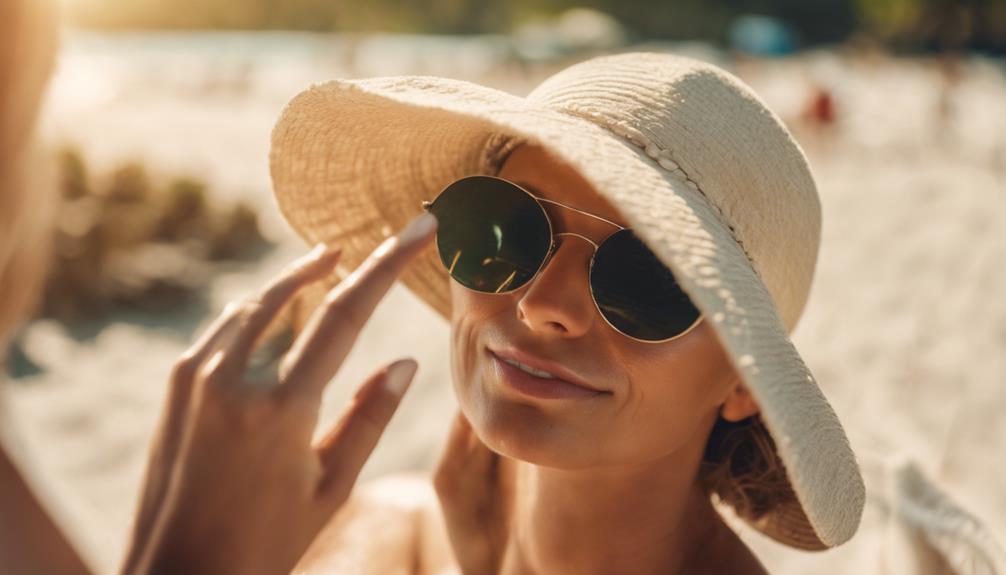
When it comes to applying sunscreen, the order and timing can make a big difference in effectiveness.
You'll want to layer it correctly, apply it ahead of time, and remember to reapply during activities for the best protection.
Let's break down the key techniques to guarantee you're fully shielded from harmful UV rays.
Order of Application
To guarantee maximum protection from UV rays, sunscreen should always be the final step in your morning skincare routine.
After you've applied your other skincare products, like moisturizer, it's time to apply sunscreen. This order of application is vital for ideal sun protection since sunscreen creates a barrier that shields your skin from harmful UV rays.
When applying sunscreen, use about one ounce to cover all exposed areas, including often-overlooked spots like your ears, neck, and tops of feet.
If you're using chemical sunscreens, remember to apply them before your moisturizer for better absorption. On the other hand, physical (mineral) sunscreens should be applied afterward to guarantee they sit on the skin's surface effectively.
Allow your sunscreen to absorb for about 15-30 minutes before applying makeup or heading outdoors. This waiting period is important for the sunscreen to form a protective layer.
Avoid layering other skincare products over the sunscreen to prevent diluting its SPF, making sure you maintain a robust defense against UV rays.
Following this order of application will provide you with the best possible protection throughout the day.
Timing for Maximum Effectiveness
Understanding the timing for sunscreen application is key to maximizing its effectiveness against harmful UV rays. To guarantee you're getting the best protection, always apply your sunscreen as the final step in your skincare routine, right after your moisturizer and any treatments. This order creates a solid barrier that helps the sunscreen do its job effectively.
For best results, make sure to apply sunscreen 15-30 minutes before heading outside. This allows the product to absorb properly and form a protective shield against UV radiation. Remember, using the right amount is vital; aim for about one ounce for full-body coverage and half a teaspoon for your face.
Avoid mixing sunscreen with other products like moisturizers, as this can dilute the SPF, reducing its effectiveness. To maintain your skin's protection throughout the day, don't forget to reapply sunscreen every two hours, especially after swimming or sweating.
Reapplication During Activities
Reapplying sunscreen during outdoor activities is vital for maintaining effective protection against harmful UV rays. To guarantee you're protecting your skin and promoting skin health, you need to reapply sunscreen every two hours or immediately after swimming or sweating.
Here are some proper application techniques to keep in mind:
- Amount of Sunscreen: Use about one ounce (a shot glass full) for full-body coverage to assure effectiveness.
- Target Missed Areas: Don't forget spots like your ears, neck, and tops of feet, as these areas are often overlooked and prone to sunburn.
- Choose the Best Sunscreen: Opt for a broad-spectrum sunscreen with at least SPF 30 for maximum protection.
Even if you choose a water-resistant formula, remember that reapplication is still necessary after two hours or after contact with water. Staying diligent about sunscreen use is vital for your skin's health, so make it a habit to reapply and enjoy your outdoor adventures worry-free!
Reapplication Guidelines
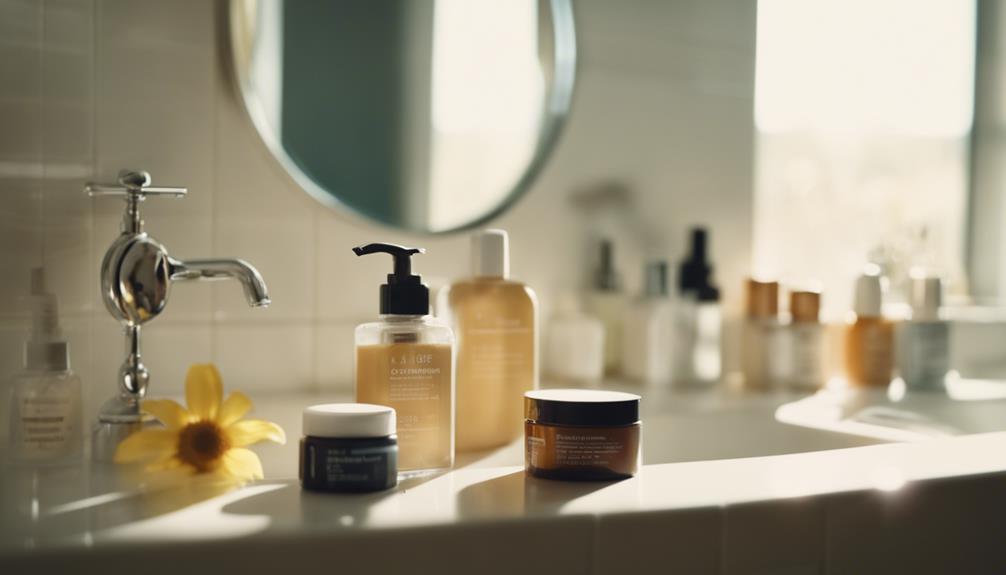
Sunscreen needs to be reapplied every two hours to confirm your skin stays protected, especially after swimming or sweating. Even if you're using a water-resistant formula, remember that its effectiveness diminishes over time. To guarantee maximum protection against harmful UV rays, including UVB rays that cause sunburn and skin aging, it's vital to incorporate sunscreen into your routine properly.
First, apply your sunscreen 15-30 minutes before sun exposure. This allows the product to absorb and form a protective barrier. Use about 1 ounce (a shot glass full) for full-body coverage, and a half teaspoon for your face and neck. Keeping your sunscreen handy makes it easy to reapply throughout the day.
If you're outdoors for an extended period, don't forget to reapply sunscreen every two hours. This consistent application helps maintain the desired protection factor (SPF) and keeps your skin safe from the sun's damaging effects.
Regular reapplication is critical, as it guarantees that your skin receives ongoing defense against the elements, ultimately preventing skin damage and premature aging. Stay vigilant, and your skin will thank you!
Makeup and Sunscreen
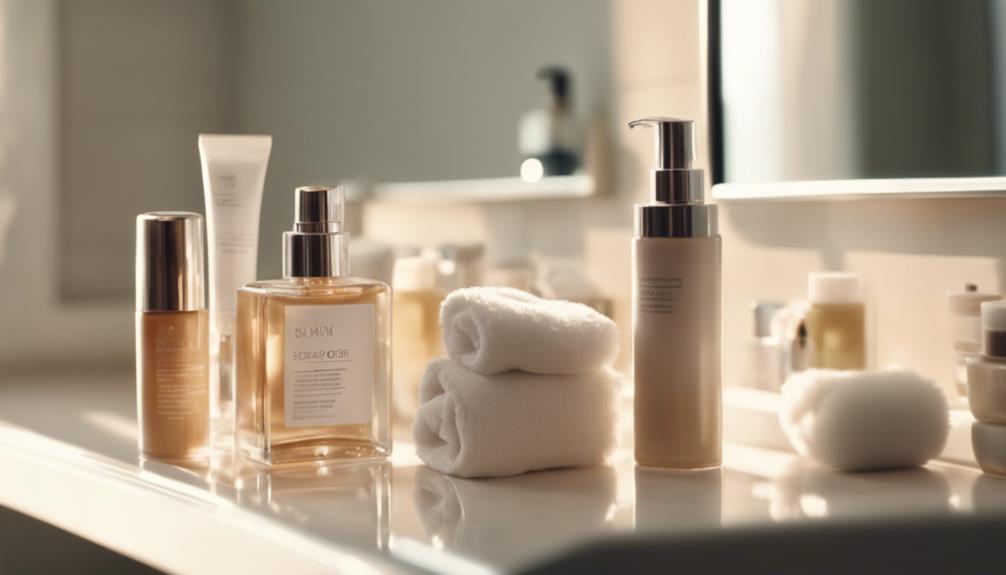
Applying sunscreen as the final step in your skincare routine is essential for creating a protective barrier before you put on makeup. It shields your skin from sun damage and guarantees that the SPF you've applied offers maximum protection.
Remember, makeup products with SPF aren't substitutes for sunscreen; they should complement it.
Here are some best practices for integrating sunscreen with your makeup routine:
- Apply Sunscreen First: Use about half a teaspoon for your face, guaranteeing even coverage on all exposed areas, including your ears and neck.
- Let It Absorb: Allow your sunscreen to absorb for at least 15-30 minutes before applying makeup to guarantee effectiveness.
- Reapply Throughout the Day: Use mineral-based setting sprays or powders with SPF to reapply sunscreen without disrupting your makeup.
Common Misconceptions
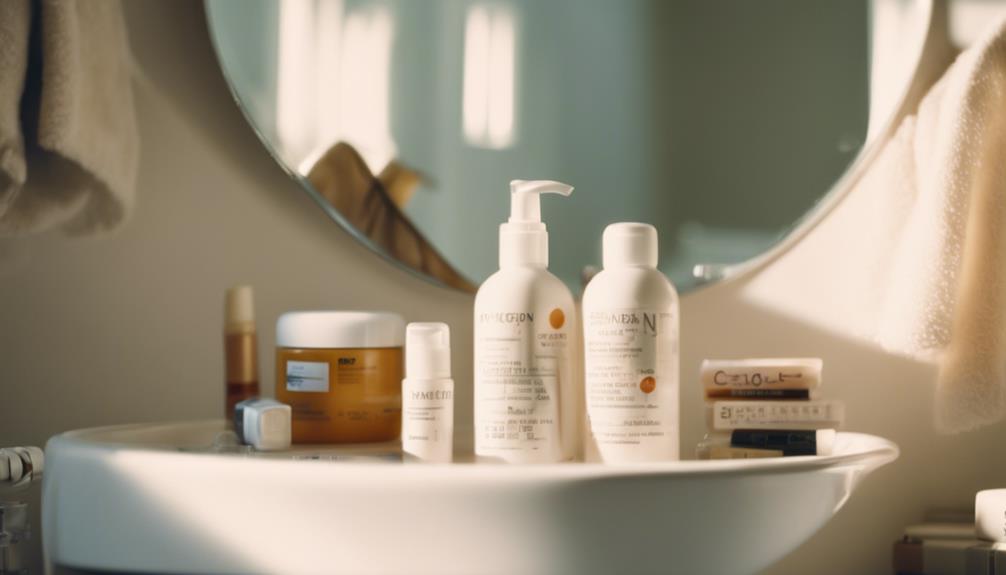
Many people mistakenly believe that sunscreen isn't necessary on cloudy days, but up to 80% of UV rays can still penetrate through the clouds. It's essential to protect your skin every day, regardless of the weather.
Another common myth is that a higher SPF means you don't need to reapply sunscreen. In reality, you should reapply sunscreen every two hours to maintain ideal protection from UV rays.
Some think that makeup products with SPF provide enough sun protection, but these products often aren't applied thick enough to deliver the advertised SPF level. Always use a dedicated sunscreen underneath your makeup for proper protection.
There's also a misconception that darker skin tones don't need sunscreen. All skin types are at risk for UV damage, which can lead to skin cancer and premature aging.
Is Sunscreen Application a Vital Step in a Skincare Routine?
Applying sunscreen is one of the most crucial detailed skincare routine steps. It protects your skin from harmful UV rays, preventing sunburn, premature aging, and skin cancer. Make sure to apply a broad-spectrum sunscreen with at least SPF 30 every day, even on cloudy days. Your skin will thank you!
Conclusion
In the grand tapestry of your skincare routine, sunscreen is the golden thread that weaves protection and beauty together.
By understanding when and how to apply it, you're not just shielding your skin from harmful rays; you're investing in its future radiance.
So, embrace this essential step, make it a cherished habit, and watch your skin bloom like a sunflower, turning toward the light while standing strong against the heat of the day.
Your skin deserves nothing less.
